Vimar 01726 Handleiding
Vimar
Niet gecategoriseerd
01726
Bekijk gratis de handleiding van Vimar 01726 (4 pagina’s), behorend tot de categorie Niet gecategoriseerd. Deze gids werd als nuttig beoordeeld door 36 mensen en kreeg gemiddeld 4.0 sterren uit 18.5 reviews. Heb je een vraag over Vimar 01726 of wil je andere gebruikers van dit product iets vragen? Stel een vraag
Pagina 1/4

Viale Vicenza, 14
36063 Marostica VI - Italy
www.vimar.com
49401437A0 02 1907
By-alarm
01726
Rivelatore By-alarm a tenda per la protezione di varchi ed infissi quali porte, fine-
stre, terrazzi coperti, corridoi di passaggio e vetrate, collegamento in radiofrequenza
868 MHz, installazione a parete, alimentato da 1 batteria litio 3 V CR2477 (fornita).
Il rivelatore è un dispositivo radio bidirezionale in grado di effettuare rilevazioni con copertura a tenda
all’interno di aree specifiche e spesso problematiche come quelle tra finestra o porta-finestra e chiusura
(tapparella o scuro) con interposta zanzariera. Il dispositivo effettua rilevazioni di tipo termico e opera su
una complessa rilevazione analoga a quella effettuata dalle termocamere. Il sensore effettua continua-
mente analisi su centinaia di punti di rilevazione termica della sua area visibile adeguando costantemente,
grazie ad uno speciale algoritmo dinamico di calcolo, le curve di rilevazione risultanti dal movimento di
un eventuale intruso nell'area interessata e dalla sua permanenza in essa per un intervallo di tempo pro-
grammabile. Dopo una serie di elaborazioni, la combinazione coincidente (AND) delle due curve risultanti
genera l'attivazione dell'allarme. L'algoritmo di calcolo dinamico adegua costantemente le variabili a fron-
te della variazione della temperatura ambiente elaborando e regolando la rilevazione secondo la modalità
di apprendimento DAL (Dynamic Adaptive Learning). Il rivelatore non necessita di alcun collegamento via
filo ed è alimentato da una batteria al litio da 3 V modello CR2477.
CARATTERISTICHE
• Alimentazione: batteria al litio 3 V CR2477 fornita in dotazione
• Range di frequenza: 868.25 MHz
• Potenza di trasmissione: 3dBm max
• Classe ricevitore: Classe 2 duty cycle <1%
• Portata: 1000 m in campo libero
• Copertura del sensore: 120° in verticale, 4° in orizzontale
• Portate del sensore:
- configurazione varco: 2,40 m
- configurazione finestra: 1,40 m
• Durata media della batteria: 2 anni
• Avviso di batteria scarica: su interfaccia radio 01729 e in centrale
• Led:
- led giallo per navigazione menù
- led verde per ricezione dati
- led rosso per trasmissione dati
• Temperatura di funzionamento: -5..+50 °C
• Dimensioni: 97x35x17 mm
BATTERIE
Il rivelatore è alimentato da una batteria al litio da 3 V modello CR2477. Quando la batteria raggiunge
il livello di 2.7 V viene inviato in centrale il segnale di "batteria scarica"; da questo momento in poi il
dispositivo rimane funzionante per altri 30 giorni circa entro i quali è necessario sostituire la batteria.
• Per sostituire la batteria si pone in modalità programmazione la centrale, digitando in tastiera il codice
installatore, e poi si sostituiscono le batterie scariche aprendo i contenitori; al termine della sostituzione
uscire dalla programmazione.
• Per ottenere una maggiore durata si consiglia di utilizzare batterie con data di scadenza di 3 anni
successiva a quella della sostituzione.
ATTENZIONE: Pericolo d'esplosione in caso di batteria sostituita con altra di tipo scorretto.
FUNZIONE DEI DIP SWITCH
Dip switch 1: In posizione ON attiva la funzione di Walk Test
Dip switch 2: Imposta la durata della permanenza nell'area protetta
Walk Test
Posizionando in ON il Dip switch 1 e premendo il pulsante RESET si attiva la funzione di Walk Test per
verificare il funzionamento del rivelatore:
- il led rosso rileva il movimento
- il led verde rileva la presenza
- il led Giallo segnala l'allarme
Dopo 5 s dallo spegnimento del led giallo, il dispositivo è pronto per una nuova rilevazione.
La funzione di Walk Test si disattiva automaticamente dopo 5 min; per attivare un nuovo ciclo di Walk
Test premere il pulsante RESET.
Nota: Durante il periodo di Walk Test il rivelatore non invia nessuna segnalazione di allarme all'interfaccia
radio 01729; le informazioni vengono visualizzate solamente attraverso i led.
Durata della permanenza
Attraverso il Dip switch 2 è possibile impostare l'intervallo di tempo nel corso del quale viene rilevata
l'eventuale presenza di un intruso.
- Dip switch 2 in OFF: 1 s
- Dip switch 2 in ON: 2 s
Aumentando la persistenza si rende più immune il rivelatore agli sbalzi termici ma al contempo si riduce
la velocità con la quale rileva un'eventuale presenza.
PRIMA ALIMENTAZIONE
Alla prima alimentazione il rivelatore effettua la mappatura termica dell'ambiente per un periodo di circa
1 min; durante questo periodo non si deve provocare nessun tipo di allarme o attraversamento dell'area
di rilevazione. Per eseguire nuovamente la mappatura termica premere il pulsante RESET.
CONFIGURAZIONE DEL RIVELATORE
La programmazione del dispositivo prevede la configurazione di diversi parametri che riguardano il fun-
zionamento, la supervisione, la potenza di trasmissione e i led. Per i dettagli relativi alla configurazione
del dispositivo si veda anche il manuale dell'interfaccia radio 01729.
Configurazioni generali
La configurazione dei rivelatori avviene mediante quattro menù; l'accesso e l'impostazione delle singole
opzioni avviene attraverso i pulsanti:
PROG: pulsante per la navigazione.
RESET: pulsante per effettuare il riavvio del dispositivo.
SELECT: pulsante per la selezione del menù.
TAMPER: pulsante per l'impostazione dei parametri.
Prima di configurare il rivelatore è sempre necessario impostare i relativi parametri.
IMPOSTAZIONE DEI PARAMETRI
I parametri del dispositivo vanno impostati con la scheda inserita nel contenitore in modo che il
tamper dell'antistrappo sia chiuso.
Dopo aver alimentato correttamente il dispositivo, tenendo premuto il pulsante , premere per 1 s PROG
e poi rilasciare il pulsante RESET.
I tre led emettono un lampeggio veloce e poi si spengono; questo indica l'accesso al Menù 1. Rilasciare,
infine, il pulsante PROG.
S elezione del menù desiderato
Per selezionare il menù desiderato esercitare una breve pressione sul pulsante ; ad ogni pressio PROG -
ne i led cambiano di stato visualizzando la relativa voce di menù come indicato nella tabella che segue:
Led accesi Descrizione del menù
R G V
Menù 1
- Configurazione Funzione, Blind Time e Led
Menù 2 -
Configurazione della sensibilità del dispositivo
Menù 3 -
Configurazione delle modalità di rilevazione
Menù 4 -
Configurazione della finestra temporale
Menù 5 -
Configurazione del Tamper e della Supervisione
Menù 6 -
Configurazione della Potenza in trasmissione
Legenda: R=led rosso, G V=led giallo, =led verde.
N.B. Nei contenuti che seguono la configurazione di default è indicata con *.
I led R e V visualizzeranno le opzioni selezionabili mentre il led G, attivabile/disattivabile attraverso
il tasto TAMPER, confermerà quella selezionata.
• M 1 enù
I led tutti spenti indicano che ci si trova sul Menù 1.
- Premere il pulsante SELECT per entrare in configurazione; i tre led lampeggeranno per 3 volte a
conferma delle selezione effettuata.
- Mediante i pulsanti TAMPER PROG per modificare e per scorrere le opzioni, impostare la funzione
desiderata come indicato nella tabella che segue:
Led accesi Led giallo spento Led giallo acceso
R V
* Configurazione Finestra Configurazione Varco
* Blind Time: 4 min Blind Time: 2 min
* Led Accesi in trasmissione e ricezione Led sempre spenti
- Per salvare e tornare al menù principale premere il pulsante ; per salvare ed uscire compleSELECT -
tamente dalla configurazione premere brevemente il pulsante RESET.
• M 2enù
Il led giallo acceso indica che ci si trova sul Menù 2.
- Premere il pulsante per entrare in configurazione; i tre led lampeggeranno per 3 volte a SELECT
conferma delle selezione effettuata.
- Per questo menù solo una delle funzioni deve essere attiva; con il pulsante scorrere le PROG
opzioni fino a trovare la configurazione desiderata e premere il pulsante TAMPER per confermare
la scelta che verrà evidenziata dall'accensione del led giallo.
Led accesi Funzioni
R V
Liv. 1: Sensibilità massima
* Liv. 2: Sensibilità alta
Liv. 3: Sensibilità media
Liv. 4: Sensibilità minima
- Per salvare e tornare al menù principale premere il pulsante ; per salvare ed uscire compleSELECT -
tamente dalla configurazione premere brevemente il pulsante RESET.
Nota. Per finestre con altezza fino a 1,4 m si consiglia di impostare il Liv. 2.
Per varchi con altezza fino a 2,4 m si consiglia di impostare il Liv. 2.
• M 3enù
Il led verde acceso indica che ci si trova sul Menù 3.
- Premere il pulsante per entrare in configurazione; i tre led lampeggeranno per 3 volte a SELECT
conferma delle selezione effettuata.
- Per questo menù solo una delle funzioni deve essere attiva; con il pulsante scorrere le PROG
opzioni fino a trovare la configurazione desiderata e premere il pulsante TAMPER per confermare
la scelta che verrà evidenziata dall'accensione del led giallo.
Led accesi Funzioni
R V
* Rilevazione di 1 evento generico
Rilevazione di 2 eventi generici
Rilevazione di 1 eventi ingresso + 1 evento uscita
Rilevazione di 3 eventi generici
- Per salvare e tornare al menù principale premere il pulsante ; per salvare ed uscire compleSELECT -
tamente dalla configurazione premere brevemente il pulsante RESET.
Nota. Per evento generico si intende uno qualsiasi tra le seguenti tipologie:
- evento ingresso, ovvero movimento della persona che entra nell’area di rilevazione e rimane
nell’area di rilevazione per un tempo superiore a quello programmato (impostazione da Dip
switch 2);
- evento uscita, ovvero movimento della persona che esce dall’area di rilevazione per un tempo
superiore a quello programmato (impostazione da Dip switch 2).
• M 4enù
Il led giallo e verde accesi indicano che ci si trova sul Menù 4, quello che permette la configurazione
delle finestra temporale.

Viale Vicenza, 14
36063 Marostica VI - Italy
www.vimar.com
49401437A0 02 1907
By-alarm
01726
- Premere il pulsante per entrare in configurazione; i tre led lampeggeranno per 3 volte a SELECT
conferma delle selezione effettuata.
- Per questo menù solo una delle funzioni deve essere attiva; con il pulsante PROG scorrere le opzioni
fino a trovare la configurazione desiderata e premere il pulsante TAMPER per confermare la scelta
che .verrà evidenziata dall'accensione del led giallo
Led accesi Funzioni
R V
Breve: 10 s
* Default: 20 s
Lunga: 40 s
Molto lunga: 90 s
- Per salvare e tornare al menù principale premere il pulsante ; per salvare ed uscire compleSELECT -
tamente dalla configurazione premere brevemente il pulsante RESET.
• M 5enù
Il led rosso acceso indica che ci si trova sul Menù 5.
- Premere il pulsante per entrare in configurazione; i tre led lampeggeranno per 3 volte a SELECT
conferma delle selezione effettuata.
- Mediante i pulsanti TAMPER PROG per modificare e per scorrere le opzioni, impostare la funzione
desiderata come indicato nella tabella che segue:
Led accesi Led giallo spento Led giallo acceso
R V
* Tamper Disattivo Tamper Attivo
Supervisione Disattiva * Supervisione Attiva
Intervallo Supervisione 8 min * Intervallo Supervisione 20 min
- Per salvare e tornare al menù principale premere il pulsante ; per salvare ed uscire compleSELECT -
tamente dalla configurazione premere brevemente il pulsante RESET.
• M 6enù
I led rosso e giallo accesi indicano che ci si trova sul Menù 6.
- Premere il pulsante SELECT per entrare in configurazione; i tre led lampeggeranno per 3 volte a
conferma delle selezione effettuata.
- Per questo menù solo una delle funzioni deve essere attiva; con il pulsante PROG scorrere le opzioni
fino a trovare la configurazione desiderata e premere il pulsante TAMPER per confermare la scelta
che .verrà evidenziata dall'accensione del led giallo
Led accesi Funzioni
R V
* Potenza bassa
Potenza media
Potenza massima
- Per salvare e tornare al menù principale premere il pulsante ; per salvare ed uscire compleSELECT -
tamente dalla configurazione premere brevemente il pulsante RESET.
INSTALLAZIONE DEL RIVELATORE
• Installare il rivelatore sul lato superiore e al centro del varco da proteggere.
• Non installare il rivelatore in prossimità di oggetti metallici e dispositivi che generino frequenze radio
come ad esempio televisori, computer, router, hot spot, ecc.
• Non esporre il rivelatore alla pioggia.
• Non installare il rivelatore alla luce diretta del sole o in posizioni dove i raggi solari lo possano colpire
durante la giornata.
• Non installare il rivelatore su infissi metallici che possano essere riscaldati dal sole o da altre fonti di
calore.
• Il corretto funzionamento del rivelatore potrebbe essere alterato se esposto a forti correnti d'aria.
• Impostare sensibilità e portata in modo adeguato al reale utilizzo.
La procedura di installazione è la seguente:
1. Impostare i parametri del dispositivo.
2. Acquisire il rivelatore sull'interfaccia radio 01729 (si veda il paragrafo 9.2 del manuale installatore
dell'interfaccia radio 01729).
3. Fissare il rivelatore, in modo provvisorio, nel punto di collocazione desiderato.
4. Effettuare un test di comunicazione per accertarsi della corretta comunicazione tra il rivelatore e
l'Interfaccia radio 01729. Se il test p2-ha avuto esito positivo, verificato con l'accensione dei led rosso
e verde sul rivelatore, procedere a fissarlo in modo definitivo o, in caso contrario, riposizionarlo ed
eseguire un nuovo test.
N.B.: Considerando le potenze in gioco e le interferenze presenti in campo è possibile che anche
minimi spostamenti del dispositivo possano migliorare o peggiorare sensibilmente la qualità di tra-
smissione. E' inoltre fondamentale eseguire una periodica manutenzione dei dispositivi per prevenire
o rilevare possibili sopravvenute interferenze esterne.
Al fine di evitare allarmi indesiderati, si consiglia di attenersi a quanto segue:
- chiudere la tapparella e la finestra per evitare lo spostamento di importanti masse d'aria.
- se possibile, riavvolgere la zanzariera.
- chiudere le porte interne degli ambienti per evitare che importanti correnti d'aria interferiscano con la
corretta rilevazione.
- il rivelatore p2-ha un funzionamento ottimale se la sua area di rilevazione è tra finestra e tapparella chiuse.
REGOLE DI INSTALLAZIONE
L’installazione deve essere effettuata da personale qualificato con l’osservanza delle disposizioni regolan-
ti l’installazione del materiale elettrico in vigore nel paese dove i prodotti sono installati.
CONFORMITA' NORMATIVA
Direttiva RED.
Norme EN 60950-1, EN 50130-4, EN 61000-6-3, EN 301 489-3, EN 300 220-2, EN 62479.
Regolamento REACh (UE) n. 1907/2006 – art.33. Il prodotto potrebbe contenere tracce di piombo.
By-alarm curtain detector to protect entrances and openings such as doors, win-
dows, covered terraces, corridors and French doors, 868 MHz radio frequency
connection, surface mounting, powered by 1 lithium battery 3 V CR2477 (included).
The detector is a two-way radio device that performs curtain cover detection within specific and often
problematic areas such as those between a window or French window and a closure (roller shutter
or blind) with a fly screen in the middle. The device detects heat and works using complex detection
methods similar to those of thermal camera systems. The sensor continuously analyses hundreds of
heat detection spots in its visible area and, using a special dynamic calculation algorithm, constantly
adapts the detection curves resulting from the movement of any intruders in the area concerned or their
presence in the area for a programmable interval of time. After a series of calculations, the coinciding
combination (AND) of the two resulting curves triggers the alarm. The dynamic calculation algorithm
constantly adapts the variables according to the variation in room temperature, processing and adjusting
the detection according to the DAL (Dynamic Adaptive Learning) method. The detector needs no wired
connection and is powered with a 3 V CR2477 model of lithium battery.
CHARACTERISTICS
• Power supply: 3 V CR2477 lithium battery included
• Frequency range: 868.25 MHz
• Transmission capacity: 3dBm max
• Receiver class: Class 2 duty cycle <1%
• Range: 1000 m in an open field
• Sensor coverage range: 120° vertical, 4° horizontal
• Sensor range:
- door configuration: 2.40 m
- window configuration: 1.40 m
• Average battery life: 2 years
• Low battery warning: on radio interface 01729 and in the control panel
• LED:
- amber LED for menu navigation
- green LED for data reception
- red LED for data transmission
• Operating temperature: -5...+50°C
• Dimensions: 97x35x17 mm
BATTERIES
The detector is powered by a 3 V CR2477 lithium battery. When the battery reaches the level of 2.7 V,
the "low battery" signal is sent to the control panel; from this point on, the device remains operational for
approximately another 30 days within which you need to change the battery.
• To change the battery set the control panel to in programming mode, entering the installer code, and
then replace the flat batteries by opening the enclosures. After changing them, exit programming.
• To ensure a longer battery life, we recommend using batteries with an expiry date 3 years after the
date of replacement.
CAUTION: Danger of explosion if the battery is replaced with one of the wrong type.
DIP-SWITCH FUNCTIONS
Dip switch 1: In ON enables the Walk Test function
Dip switch 2: Sets the duration in the protected area
Walk test
Placing Dip switch 1 ON and pressing the RESET button the Walk Test function is enabled to check
the detector operation:
- the red LED detects motion
- the green LED detects a presence
- the yellow LED signals an alarm
5 s after the yellow LED goes out the device is ready for a new detection.
The Walk Test is disabled automatically after 5 min; to enable a new Walk Test cycle press the RESET
button.
Note: During the Walk Test the detector does not send any alarm signal to the 01729 radio interface;
the information is only displayed by the LEDs.
Duration
Dip switch 2 is used to set the time interval during which the presence of an intruder is detected.
- DIP-switch 2 OFF: 1 s
- Dip switch 2 ON: 2 s
By increasing the persistence the detector is made more immune to heat differences but at the same
time this reduces the speed at which any presence is detected.
FIRST POWER-UP
When first powered up the detector runs a heat mapping of the room for around 1 minute; during this
period no alarms must be triggered and the detection area must not be crossed. To run a new heat
mapping, press the RESET button.
DETECTOR CONFIGURATION
Programming the device requires configuring several parameters that affect the operation, supervision,
transmission capacity and LEDs.
For details on the configuration of the device, please see also the radio interface 01729 manual.
General configurations
The detectors are configured via four menus; the single options are accessed and set via the push-but-
tons:
PROG: navigation push-button.
RESET: push-button for restarting the device.
SELECT: push-button for menu selection.
TAMPER: push-button for setting the parameters.
Before configuring the detector it is always necessary to set the relevant parameters.
SETTING PARAMETERS
The device parameters are set with the card inserted in the enclosure so that the tear-proof tamper
is closed.
After correctly powering up the device, keeping the push-button pressed, press for 1 s and then PROG
release the button.RESET
Vimar SpA dichiara che l’apparecchiatura radio è conforme alla direttiva 2014/53/UE. Il testo completo
della dichiarazione di conformità UE è disponibile nella scheda di prodotto al seguente indirizzo Internet:
www.vimar.com.

Viale Vicenza, 14
36063 Marostica VI - Italy
www.vimar.com
49401437A0 02 1907
By-alarm
01726
The three LEDs will emit a fast blink and then go out; this indicates access to Menu 1. Lastly, release
the PROG button.
S electing the desired menu
To select the desired menu, briefly press the button; each time it is pressed the LEDs change PROG
status, showing the related menu item as shown in the table below:
LEDs on Descriptions of the menu
R Y G
Menu 1
- Function, Blind Time and LED configuration
Menu 2 -
Device sensitivity configuration
Menu 3 -
Detection mode configuration
Menu 4 -
Time window configuration
Menu 5 -
Tamper and Supervision configuration
Menu 6 -
Transmission capacity configuration
Legend: R=Red LED, Y=Yellow LED, =Green LED.G
N.B. In the following contents the default configuration is indicated by *.
The R and G LEDs display the selectable options and the Y LED, activated/deactivated with the
TAMPER button, confirms the selected one.
• Menu 1
When all LEDs are off you are in Menu 1.
- Press the push-button to enter the configuration; the three LEDs will blink 3 times to confirm SELECT
the selection made.
- Using the TAMPER PROG push-button to edit and the push-button to scroll through the options, set
the desired function as shown in the table below:
LEDs on Yellow LED off Yellow LED on
R G
* Window Configuration Door Configuration
* Blind Time: 4 min Blind Time: 2 min
* LEDs on in transmission and reception LEDs always off
- To save and return to the main menu, press the button; to save and exit configuration comSELECT -
pletely, briefly press the button.RESET
• Menu 2
When the you are in Menu 2.yellow LED is on
- Press the push-button to enter the configuration; the three LEDs will blink 3 times to SELECT
confirm the selection made.
- For this menu, only one of the functions must be active; using the button, scroll through the PROG
options until you find the desired configuration and press the TAMPER button to confirm the choice
that .will be highlighted by the yellow LED coming on
LEDs on Functions
R G
Lev. 1: Maximum sensitivity
* Lev. 2: High sensitivity
Lev. 3: Medium sensitivity
Lev. 4: Minimum sensitivity
- To save and return to the main menu, press the button; to save and exit configuration comSELECT -
pletely, briefly press the button.RESET
Note. For windows up to 1.4 m high set Lev. 2.
For doors up to 2.4 m high set Lev. 2.
• M 3enù
When the you are in Menu 3.green LED is on
- Press the push-button to enter the configuration; the three LEDs will blink 3 times to SELECT
confirm the selection made.
- For this menu, only one of the functions must be active; using the button, scroll through the PROG
options until you find the desired configuration and press the TAMPER button to confirm the choice
that .will be highlighted by the yellow LED coming on
LEDs on Functions
R G
* Detection of 1 generic event
Detection of 2 generic events
Detection of 1 entry event + 1 exit event
Detection of 3 generic events
- To save and return to the main menu, press the button; to save and exit configuration comSELECT -
pletely, briefly press the button.RESET
Note. Generic event refers to any of the following types:
- entry event, the movement of a person entering the detection area and who remains in the
detection area for more than the time programmed (setting from Dip switch 2);
- exit event, the movement of a person leaving the detection area for more than the time pro-
grammed (setting from Dip switch 2).
• M 4enù
The yellow and green LEDs on indicate that Menu 4 is active, used to configure the time window.
- Press the push-button to enter the configuration; the three LEDs will blink 3 times to SELECT
confirm the selection made.
- For this menu, only one of the functions must be active; using the button, scroll through the PROG
options until you find the desired configuration and press the TAMPER button to confirm the choice
that .will be highlighted by the yellow LED coming on
LEDs on Functions
R G
Short: 10 s
* Default: 20 s
Long: 40 s
Very long: 90 s
- To save and return to the main menu, press the button; to save and exit configuration comSELECT -
pletely, briefly press the button.RESET
• Menu 5
When the you are in Menu 5.red LED is on
- Press the push-button to enter the configuration; the three LEDs will blink 3 times to confirm SELECT
the selection made.
- Using the TAMPER PROG push-button to edit and the push-button to scroll through the options, set
the desired function as shown in the table below:
LEDs on Yellow LED off Yellow LED on
R G
* Tamper Off Tamper On
Supervision Off * Supervision On
Supervision Interval 8 min * Supervision interval 20 min
- To save and return to the main menu, press the button; to save and exit configuration comSELECT -
pletely, briefly press the button.RESET
• Menu 6
When the you are in Menu 6.red and yellow LEDs are on
- Press the push-button to enter the configuration; the three LEDs will blink 3 times to confirm SELECT
the selection made.
- For this menu, only one of the functions must be active; using the button, scroll through the PROG
options until you find the desired configuration and press the TAMPER button to confirm the choice
that .will be highlighted by the yellow LED coming on
LEDs on Functions
R G
* Low power
Medium power
Maximum power
- To save and return to the main menu, press the button; to save and exit configuration comSELECT -
pletely, briefly press the button.RESET
INSTALLING THE DETECTOR
• Install the detector on the top and in the centre of the door to be protected.
• Do not install the detector in the vicinity of metal objects and devices that generate radio frequencies
such as televisions, computers, routers, hot spots, etc.
• Do not expose the detector to rain.
• Do not install the detector in direct sunlight or in a position where it may be lit by solar rays during
the day.
• Do not install the detector on metal doors or windows which could be heated by the sun or other
heat sources.
• The correct operation of the detector could be altered if exposed to strong air currents.
• Set the sensitivity and range suited to actual use.
The installation procedure is as follows:
1. Configure the detector (see paragraph 9.2 of the radio interface installer manual 01729).
2. Acquire the detector on the radio interface 01729.
3. Secure the detector, provisionally, in the desired location.
4. Run a communication test to ensure proper communication between the detector and the radio inter-
face 01729. If the test is successful, verified with the red and green LEDs on the detector lighting up,
secure it permanently or, on the contrary, reposition it and perform a new test.
N.B.: Considering the powers involved and the interferences present in the field it is possible that
even the smallest movements of the device may significantly improve or worsen the transmission
quality.
It is also important to perform periodic maintenance on the devices to prevent or detect any possible
external interference.
To avoid unwanted alarms, it is advisable to comply with the following:
- close the roller shutter and window to avoid significant air movements.
- if possible, wind up the fly screen.
- close the inner doors in the rooms to prevent air currents from interfering with correct detection.
- the detector works best if its detection area is between the window and the closed roller shutter.
INSTALLATION RULES
Installation should be carried out by qualified personnel in compliance with the current regulations regard-
ing the installation of electrical equipment in the country where the products are installed.
REGULATORY COMPLIANCE
RED directive.
Standards EN 60950-1, EN 50130-4, EN 61000-6-3, EN 301 489-3, EN 300 220-2, EN 62479.
REACH (EU) Regulation no. 1907/2006 – Art.33. The product may contain traces of lead.
Vimar SpA declares that the radio equipment complies with Directive 2014/53/EU. The full text of the
EU declaration of conformity is on the product sheet available at the following Internet address: www.
vimar.com.
Product specificaties
| Merk: | Vimar |
| Categorie: | Niet gecategoriseerd |
| Model: | 01726 |
Heb je hulp nodig?
Als je hulp nodig hebt met Vimar 01726 stel dan hieronder een vraag en andere gebruikers zullen je antwoorden
Handleiding Niet gecategoriseerd Vimar
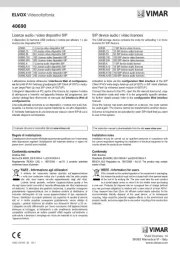
2 September 2025
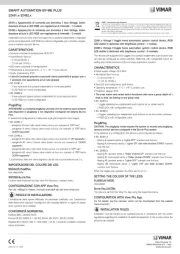
26 Augustus 2025
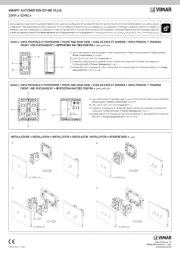
26 Augustus 2025
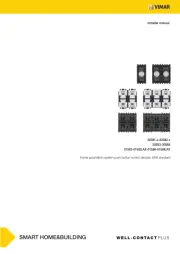
26 Augustus 2025
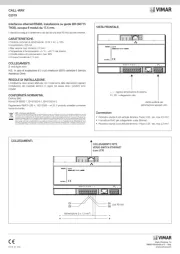
14 Augustus 2025
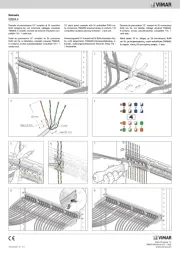
5 Juli 2025
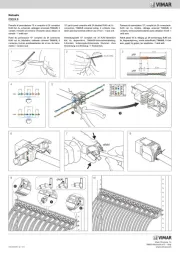
5 Juli 2025
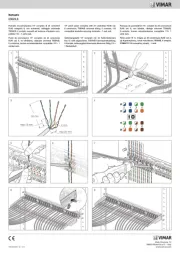
5 Juli 2025

5 Juli 2025
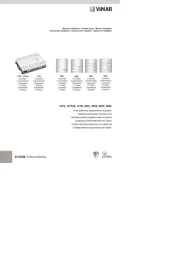
24 Mei 2025
Handleiding Niet gecategoriseerd
- Toa
- Roger Schult
- Hellberg
- Aicon
- Maxwell
- Ei Electronics
- Westcott
- Milan
- Noma
- Olympia
- Creative
- Sommer
- Mellerware
- Dualit
- Extralife Instruments
Nieuwste handleidingen voor Niet gecategoriseerd
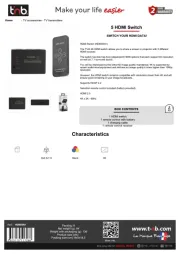
15 September 2025
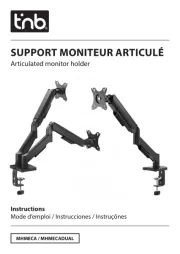
15 September 2025

15 September 2025

15 September 2025
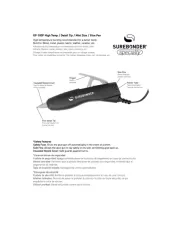
15 September 2025

15 September 2025

15 September 2025

15 September 2025
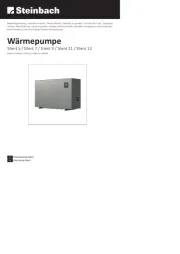
15 September 2025
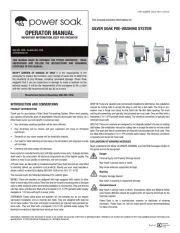
15 September 2025